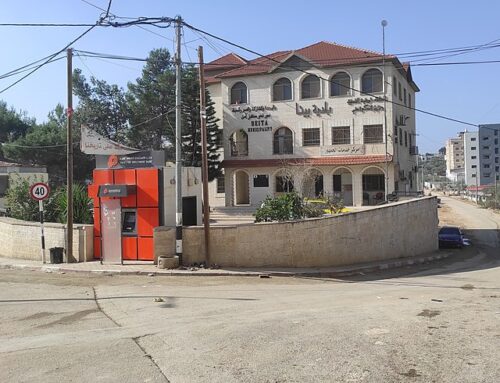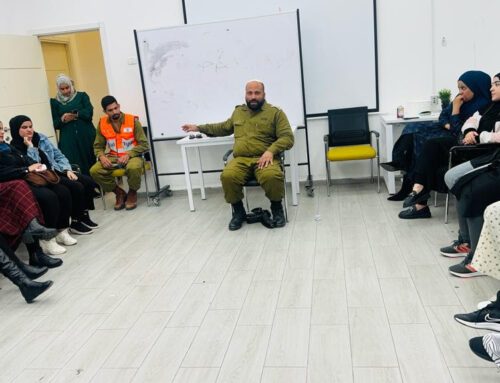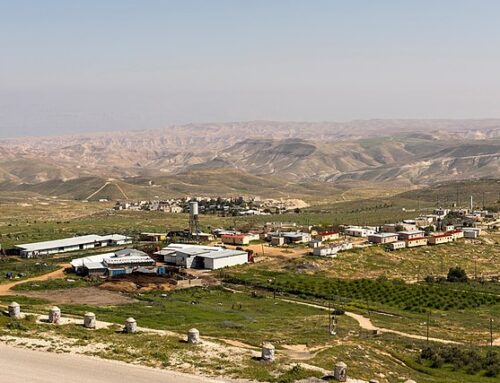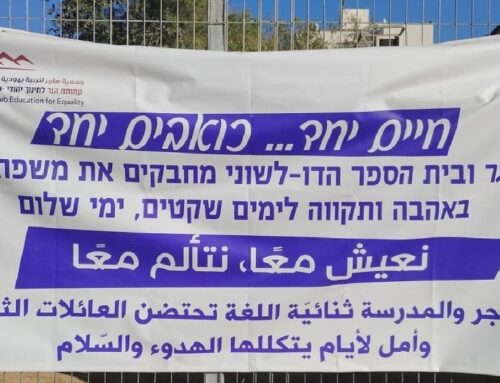Irwin Wall continues from Part 2, to conclude his reflections on our “Israel Symposium,” Oct. 20-27:
 |
| Noam Sheizaf (rt.) with Shani Chabansky of our group. |
How can Israel harbor in its Jewish population the incredible diversity of opinion to which we were exposed over six and a half intensive days? To listen to Dov Henin is to visit another planet. Dayan wants to occupy and oppress the Arabs. Henin wants to live with them on the basis of total and full equality. He is a Jewish MK representing a mostly Arab party, known as Hadash, formed in part by Israeli communists. Henin sees no moral alternative to a Jewish-Arab political party in what must in the end become a Jewish-Arab polity. How Jews deal with their Arab population must be the acid test of the democracy and morality of the Zionist enterprise. Hadash has only four MKs. Even added to the three for Meretz, the Israeli left does not add up to very much these days.
Meretz is campaigning on the theme “Leftists go home.” A phrase once meant to tell leftists to go back to Russia, Meretz takes it to mean that while 6-8% of Israelis may vote their way, they actually could total 18-20% of the electorate. Meretz proposes to win them back. The evidence, however, is that being left isa negative in the eyes of most voters.
Noam Sheizaf, a young progressive journalist, isa founder of the web publication 972mag.com(972 being Israel’s telephone country code). Young progressives are trying to rejuvenate the left and adapt it to the new age. They staff numerous human rights organizations, the NGOs that dot the political landscape and which the Netanyahu government seeks to repress, and most importantly, they played a critical role in the protests of 2011. Although primarily a struggle against the high cost of living, Sheizaf sees the demonstrators as animated by progressive ideals;their effect on the Israeli political landscape has yet to be felt. However, we met one of the leading luminaries of the movement, Stav Shaffir, who has chosen to be a candidate of the rather staid Labor Party.
The Symposium included several field trips, all of great interest. For many of us the most dispiriting experience was exploring the madness of the Israeli occupation and adjoining colonization of Hebron. To see what was once the main central artery and market of the town now patrolled only by Israeli soldiers, peopled by Israeli foot-traffic, with Palestinians restricted to a pathway behind a barricade, was disheartening. A small group of Jews, animated by religious fanaticism, insert themselves into a large Palestinian city (of about 175,000), and enforce their presence through the complicity of the Israeli army.
In East Jerusalem, Jewish neighborhoods have been placed between what were once West Bank Arab villages, cutting them off from one another while incorporating their residents involuntarily into the state of Israel. They are permitted to vote in Jerusalem municipal elections, and have voted in Palestinian Authority elections. They live in sight of the horrible barrier, or wall (the words themselves are politicized), that ostensibly has been erected to control terrorism and illegal infiltration into Israel.
There is little good to say about Israeli treatment of the Bedouins either. In Beersheva, we meet with Vivian Silver, a Canadian-Israeli kibbutznik who co-directs the Negev Institute for Strategies of Peace and Development with a Bedouin woman colleague. Once a nomadic group, most Bedouin were forced into designated towns without adequate means of earning a livelihood. Others struggle to remain in villages of their own choosing, which are repeatedly condemned and demolished because the state refuses to recognize them.
From Beersheva, we went to the northern edge of the Gaza Strip;one of several temporary cease-fires allowed us to proceed in a calm between storms. Our host, from a local kibbutz, was a member of a group of Israelis and Gazans called “Another Voice,” who contact each other by email and cell phone to provide emotional and material support where possible. They (naively?) believe that destiny does not dictate the current state of hostility that exists between Hamas and Israel. Our host uttered an intriguing thought: what if one day the 1.7 million inhabitants of the strip, squeezed into a space of 141 square miles, decided, instead of occasionally lobbing rockets over their fence, instead tore it down with their hands and en masse, walked across the demarcation line into Israel? This might be Israel’s greatest challenge.
It is also both dispiriting and uplifting to visit Tel Aviv’s Levinsky Park, now occupied by Sub-Saharan Africans, refugees from places of war, pestilence and starvation, who have made the trekfrom South Sudan and Eritrea for the most part.Israel is enjoined from forcibly repatriating them by international law if they risk persecution or death in their countries of origin. But it does nothing for those in the country and builds a fence to keep out any more. Still, the people of Tel Aviv save the honor of the Jewish people, led by a selfless organizer named Yigal Shtayim; a soup kitchen appears in the evenings, which the refugees themselves help organize as it distributes vast amounts of food thatIsraelis bring daily. Even the restaurants pitch in with leftover food, as Yigal Shtayim sees to it that the park’s inhabitants and hangers-on are fed at least one good meal per day.
Unfortunately, the outlook for change in the current elections remains dim. Zahava Gal-on, the impressive woman now at the head of Meretz, recognizes the obstacles in our parting meeting, but she remains optimistic. Pessimism is a luxury we cannot afford, she says.






Leave A Comment